I’ve been thinking all day of how to meet you here, as my Lenten Journal begins for another year. Tonight I was looking through some notes and found this quote from James Baldwin in an article in Brainpickings.
Once people know what they know, they make the unconscious assumption that they were born knowing what they know, and forget that they had to learn everything they know.
His words reminded me of my favorite passage from T. H. White’s The Once and Future King. Merlin is speaking to Arthur:
The best thing for being sad . . . is to learn something. That is the only thing that never fails. You may grow old and trembling in your anatomies, you may lie awake at night listening to the disorder of your veins, you may miss your only love, you may see the world about you devastated by evil lunatics, or know your honor trampled in the sewers of baser minds. There is only one thing for it then — to learn. Learn why the world wags and what wags it. That is the only thing which the mind can never exhaust, never alienate, never be tortured by, never fear or distrust, and never dream of regretting.
The oldest roots of the word learn mean “to follow the track.” Learning, at its heart, is less about amassing information or proving a point and more about seeing where things will take you. If we only go looking for things that will support what we think we have nailed down, we won’t learn a thing.
Lent, like any of the seasons of the liturgical year, I suppose, can be a journey around a familiar track. We all know we are on the road to the Cross. We all know there’s an empty tomb at the end of the story. The path is so familiar we don’t even have to say, “Spoiler alert.” We know Judas sells Jesus out. We know Peter denies him. We know the disciples lock themselves in the Upper Room out of fear. We know that up from the grave he arose.
But what if we don’t know?
What if there is more to learn? What would it take to listen as though we weren’t the ones who knew what it was all about?
Last week, I was in Memphis with a group from our church on a Civil Rights History Tour, which is an annual event Ginger leads to a different city to help us understand our place in changing the narrative of racism that is at the heart of so much of American history. We saw the story lived out in Memphis in both the churches and the blues–and we got a good taste of both.
This morning I began the first of my books for Lent, The Cross and the Lynching Tree by James Cone. He talks about the role of both the blues and the church in the struggle for civil rights.
The blues prepared people to fight for justice by giving them a cultural identity that made them human and thus ready to struggle. The blues sent people traveling, roaming, looking for a woman or a man to soothe one’s aching heart. But it was Jesus’ cross that sent people protesting in the streets, seeking to change the social structures of racial oppression.
Cone said a couple of other things in the chapter I read that made me want to learn this Lent.
The more black people struggled against white supremacy, the more they found in the cross the spiritual power to resist the violence they so often suffered. . . . Just as Jesus did not deserve to suffer, they knew they did not deserve it; yet faith was the one thing that white people could not control or take away. . . .
Because of their experience of arbitrary violence, the cross was and is a redeeming and comforting image for many black Christians. If the God of Jesus’ cross is found among the least, the crucified people of the world, then God is also found among those lynched in American history. . . . The final word about black life is not death on a lynching tree but redemption in the cross–a miraculously transformed life found in the God of the gallows. . . . The cross places God in the middle of crucified people.”
I listened to someone talk recently about what the Church had to say to America about racism. They seemed to assume that those not in church were waiting on a word, or expecting us to lead. I began to think about when the Church has offered a prophetic voice and, as I thought about the Civil Rights Movement or liberation theology, it seemed to me that the prophetic voices come mostly from the margins, not from the halls of power and the rooms filled with The People Who Know. Those who speak truth to power are the prophets, and they are the ones still on the receiving end of most of the suffering.
They are walking the track I want to follow this Lenten season. I have a lot to learn.
Peace,
Milton

What an excellent beginning….hope to follow each day. I am reading Stained from the Beginning. And learning. Thanks for another title.
Your words always nourish my soul as I begin my Lenten journey. Thank you for the inspired words, dear Milton.
Milton –
You speak to my soul. Thank you for taking the time to write and post.
With gratitude,
Diane W.
If God gives * * * * * five star reviews for a piece of the genuine article
. . . “thou art the man!”